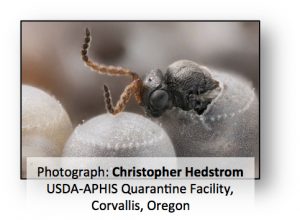
Overview: This project is dedicated to the sustainable, biological control of the Asian invasive brown marmorated stink bug (BMSB), Halyomorpha halys (Stal) in New York State using the Samurai Wasp, now resident in the mid-Hudson Valley of NY.
This approach has the potential to dramatically reduce BMSB in homes, while reducing pesticide use for its control in the urban and agricultural environment. Your participation will help support Agricultural Research while reducing the pests impact on the crops grown by your local farmers in NYS where the Samurai is released.
Introduction: The Asian invasive brown marmorated stink bug (BMSB), Halyomorpha halys (Stal) was first introduced into the US in the mid-1990’s. This species of stink bug differs considerably from our native species in its preference to overwinter in homes and man-made structures. As an urban pest it can dwell in homes with populations exceeding 20,000 adults as an overwhelming nuisance pest.

In years which the BMSB has 2 generations, populations can increase exponentially during summer. This occurs during harvest when it becomes extremely difficult to manage, causing considerable injury to late season peach, apple, organic sweet corn, pepper and tomato, adding insecticide residue to crops.
In 2016 we observed the emergence of the adventive Asian Samurai Wasp, Trissolcus japonicus from a sentinel egg survey of Mid-Hudson Valley farms of NYS in 2016. This wasp also from Asia and is closely related to our native Trissolcus species. This micro-hymenopteran wasp is only 2 mm in length, does not sting, feeds on small flowers and lays its eggs almost exclusively into the eggs of the BMSB.
As such, Samurai Wasp is highly specific in its parasitism of the brown marmorated stink bug, and highly effective in reducing BMSB populations. In its native Asian environment, the wasp has provided in excess of 50% reduction of the BMSB.
DEC approvals are now in place to utilize the Samurai Wasp this season to begin bio-control of BMSB populations in the agricultural regions of NY. States introducing the Samurai Wasp in 2017 include PA, WV, MD, DE, Washington and Oregon.
Your participation will introduce a natural control of reducing brown marmorated stink bug in your neighborhood. This process will also help your local farmer to reduce the injury BMSB has on their crops.
Contact us to receive a cluster of eggs containing the Samurai Wasp for release into your community. We simply need your address of where the wasps will be released and with the packet we’ll send instructions on how to proceed. We are asking for additional support to cover shipping and help us offset the costs of laboratory rearing and colony maintenance of this project.
The Hudson Valley Research laboratory (FARM) was built and in 1963 by the farmers of the Hudson Valley who is own the lab, pay for maintenance and operations of the buildings and grounds and see the value of the research we conduct. Over the past three years our Citizen Science participants have included donations ranging from $30 to $1000.00 in support of these efforts. Please consider a donation to offset the costs that the farmers have taken on for the work we do while supporting regional agriculture and food production in the Hudson Valley.
Hudson Valley Research Laboratory
Department of Entomology
Hudson Valley Research Lab
P.O. Box 727, 3357 Rt. 9W
Highland, NY 12528
If you’d like to be a part of the on-going re-distribution project, we would send along a set of instructions on how to ‘recapture’ the wasp using sentinel eggs that we would provide weekly with return envelopes. The sentinel eggs are glued to the lid of petri dishes, which would be opened and hung in BMSB host plant within 30 meters from the release site. If the wasps were successful in establishing they would then locate these sentinel eggs, begin laying their eggs into the BMSB sentinel eggs. You would then return the eggs to our laboratory. Shortly thereafter Samurai Wasps would begin emerging from the eggs. We would then identify these wasps to determine the successful establishment of the Samurai Wasp in your location and we would let you know of their success. How cool is that??
Thanks for your support!
Peter Jentsch
Director of the Hudson Valley Research Laboratory


